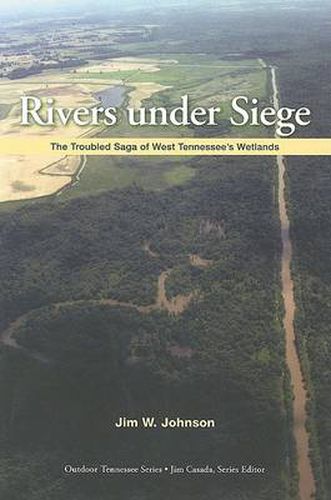Readings Newsletter
Become a Readings Member to make your shopping experience even easier.
Sign in or sign up for free!
You’re not far away from qualifying for FREE standard shipping within Australia
You’ve qualified for FREE standard shipping within Australia
The cart is loading…






Rivers under Siege is a wrenching firsthand account of how human interventions, often well intentioned, have wreaked havoc on West Tennessee’s fragile wetlands. For more than a century, farmers and developers tried to tame the rivers as they became clogged with sand and debris, thereby increasing flooding. Building levees and changing the course of the rivers from meandering streams to straight-line channels, developers only made matters worse. Yet the response to failure was always to try to subdue nature, to dig even bigger channels and construct even more levees-an effort that reached its sorry culmination in the U.S. Army Corps of Engineers’ massive West Tennessee Tributaries Project during the 1960s. As a result, the rivers’ natural hydrology descended into chaos, devastating the plant and animal ecology of the region’s wetlands. Crops and trees died from summer flooding, as much of the land turned into useless, stagnant swamps.
The author was one of a small group of state waterfowl managers who saw it all happen, most sadly within the Obion-Forked Deer river system and at Reelfoot Lake. After much trial and error, Johnson and his colleagues in the Tennessee Wildlife Resources Agency began by the 1980s to abandon their old methods, resorting to management procedures more in line with the natural contours of the floodplains and the natural behavior of rivers. Preaching their new stewardship philosophy to anyone who might listen-their supervisors, duck hunters, conservationists, politicians, federal agencies-they were often ignored. The campaign dragged on for twenty years before an innovative and rational plan came from the Governor’s Office and gained wide support. But then, too, that plan fell prey to politics, legal wrangling, self-interest, hardheadedness, and tradition. Yet, despite such heartbreaking setbacks, the author points to hopeful signs that West Tennessee’s historic wetlands might yet be recovered for the benefit of all who use them and recognize their vital importance.
Jim W. Johnson, now retired, was for many years a lands management biologist with the Tennessee Wildlife Resources Agency. He was responsible for the overall supervision and coordination of thirteen wildlife management areas and refuges, primarily for waterfowl, in northwest Tennessee.
$9.00 standard shipping within Australia
FREE standard shipping within Australia for orders over $100.00
Express & International shipping calculated at checkout
Rivers under Siege is a wrenching firsthand account of how human interventions, often well intentioned, have wreaked havoc on West Tennessee’s fragile wetlands. For more than a century, farmers and developers tried to tame the rivers as they became clogged with sand and debris, thereby increasing flooding. Building levees and changing the course of the rivers from meandering streams to straight-line channels, developers only made matters worse. Yet the response to failure was always to try to subdue nature, to dig even bigger channels and construct even more levees-an effort that reached its sorry culmination in the U.S. Army Corps of Engineers’ massive West Tennessee Tributaries Project during the 1960s. As a result, the rivers’ natural hydrology descended into chaos, devastating the plant and animal ecology of the region’s wetlands. Crops and trees died from summer flooding, as much of the land turned into useless, stagnant swamps.
The author was one of a small group of state waterfowl managers who saw it all happen, most sadly within the Obion-Forked Deer river system and at Reelfoot Lake. After much trial and error, Johnson and his colleagues in the Tennessee Wildlife Resources Agency began by the 1980s to abandon their old methods, resorting to management procedures more in line with the natural contours of the floodplains and the natural behavior of rivers. Preaching their new stewardship philosophy to anyone who might listen-their supervisors, duck hunters, conservationists, politicians, federal agencies-they were often ignored. The campaign dragged on for twenty years before an innovative and rational plan came from the Governor’s Office and gained wide support. But then, too, that plan fell prey to politics, legal wrangling, self-interest, hardheadedness, and tradition. Yet, despite such heartbreaking setbacks, the author points to hopeful signs that West Tennessee’s historic wetlands might yet be recovered for the benefit of all who use them and recognize their vital importance.
Jim W. Johnson, now retired, was for many years a lands management biologist with the Tennessee Wildlife Resources Agency. He was responsible for the overall supervision and coordination of thirteen wildlife management areas and refuges, primarily for waterfowl, in northwest Tennessee.